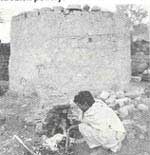New kilns that are cheaper and better
 TRADITIONAL Indian potters face both low availability and high cost of firewood, which is used as fuel in kilns, forcing several of them to the brink of closure. Now, two scientists at the Regional Research Laboratory in Bhubaneswar have devised a low-cost pottery kiln that operates on coal and hope it can revive the pottery sector.
TRADITIONAL Indian potters face both low availability and high cost of firewood, which is used as fuel in kilns, forcing several of them to the brink of closure. Now, two scientists at the Regional Research Laboratory in Bhubaneswar have devised a low-cost pottery kiln that operates on coal and hope it can revive the pottery sector.
S Khuntia and J S Murty claim their kiln uses only about 250 gm of coal per kg of burnt pottery, compared to a traditional kiln, which uses about 1.2 kg of firewood for the same weight of burnt pottery. This translates into a 70 per cent saving of fuel in terms of cost.
The new kiln is made of ordinary bricks and mud and has other advantages over the traditional kiln: a rapid turnover time -- 1 day as opposed to 3 days in a conventional kiln; reduced breakage because of more uniform heating -- one per cent as opposed to 15 per cent to 20 per cent in usual kilns superior product quality, and increased scope for higher value added pottery. The new kiln also doesn't have to be constructed afresh every time the potter intends to fire his fare.
The Orissa Renewable Energy Development Agency, which is promoting the kiln, has established 12 kilns in Cuttack, Puri, Kendrapada and Sambalpur districts. One kiln was recently inaugurated in Puri to supply small earthen pots for distributing prasad at the temple of Lord Jagannath.
